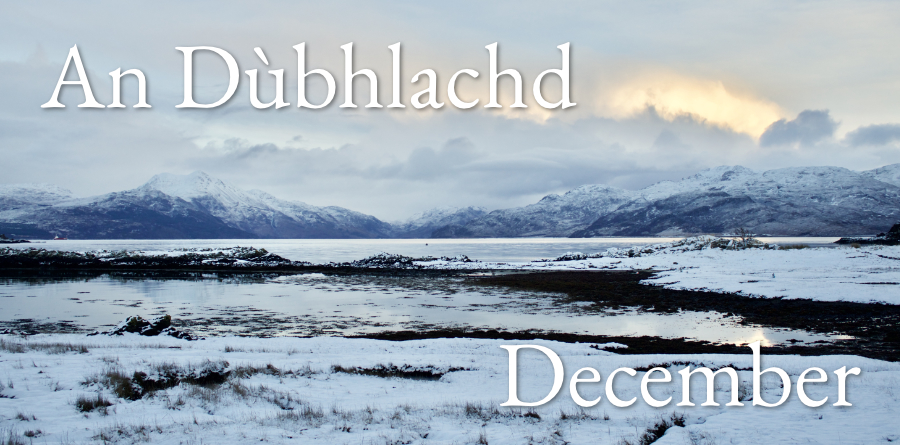Unlike in English, the months in Gaelic are preceded by the word ‘the’ and as you would expect, are linked to describing that particular time of year. ‘An Dùbhlachd’ (pronounced ‘an doolachk’ with the ‘ch’ as in ‘loch’) means the ‘darkness’ or ‘blackness’ and of course refers to the short days and long nights that we have this month, leading to the winter solstice on the 22nd of December.
The word ‘Cailleach’ (again the ‘ch’ sound as in ‘loch’) in Scottish Gaelic is usually used in referring to an older lady but this word was long associated with the winter goddess in ancient Gaelic culture. There are lots of stories associated with this goddess known as the ‘cailleach’, who was neither a good or bad figure and today with have plenty of Gaelic placenames which are linked to her too with many examples of this here in Skye.
The ‘cailleach’ in some ways is the equivalent of what we would describe as ‘mother nature’ and the cailleach was the goddess in particular of the winter months. She is said to control the winter weather and traditionally her main season ran from the 31st of October to the 1st of February, when she is said to run out of her store of winter firewood. On that day, if it was fine and dry, she would be able to gather more firewood and thus be able to prolong winter a little bit longer but if it was a wet day, she would have no fuel and thus would have to give way to Spring. Some believe that this traditional concept travelled to America with the emigrant Gaels where it has morphed into ‘Groundhog Day’!
The 1st of February, was marked in the Celtic calendar as ‘Imbolc’ and was the halfway point between the winter solstice and Spring equinox. It was a time to celebrate new beginnings and hopefully the onset of Spring and various customs and celebrations took place that day. With the arrival of Christianity, many of these ancient festivals that recognised these important days of the seasons were remolded as Christian celebrations and in the Gaelic culture of Ireland and Scotland this became St Brigid’s day, one of the patron saints of Ireland. This is when the custom of making St Brigid’s cross took place and this still happens in certain parts of the Highlands and Islands. Therefore, the ‘Cailleach’ in ancient culture was replaced with another feminine icon in the form of St Brigid.
Of course our celebration of Christmas is perhaps the most notable example of ancient traditions becoming a Christian festival, with what was originally the marking of the winter solstice becoming Christmas, as we know it now.
New Year’s day in Gaelic culture is known as ‘a’ Challainn’ (pronounced ‘chaleen’ with the ‘ch’ as in loch again.) and New year’s eve is known as ‘Oidhche Challainn” (oidhche means night and is pronounced ‘ayechuh’ with ch again as in loch). This was another time of celebrations, rituals and customs. ‘First footing’ as it is now known was a time to visit family and friends in the early hours of New Year’s Day and to wish them a healthy and happy year ahead. Children would dress up, certain rhymes were said and drams were taken – only by the adults of course!
Some say that this word Callainn is linked to the word calends or kalends, which comes from the latin word ‘calendae’ meaning the first day of each month in the ancient Roman year. From this Latin word we of course get the word ‘calendar’ in English!
But in many parts of the Highlands and Islands, Oidhche Challainn or New Year’s Eve, was originally held on the 12th of January and this is still known in Skye as the old New Year. Here at Hotel Eilean Iarmain, this was often marked with a cèilidh and celebration amongst staff, locals and guests. This is because the 13th of January was the New Year’s day of the Julian calendar but when this was replaced by the Gregorian calendar in 1752, New Year became the date as we have it now but the old New Year is still celebrated in many parts of Scotland to this day!



